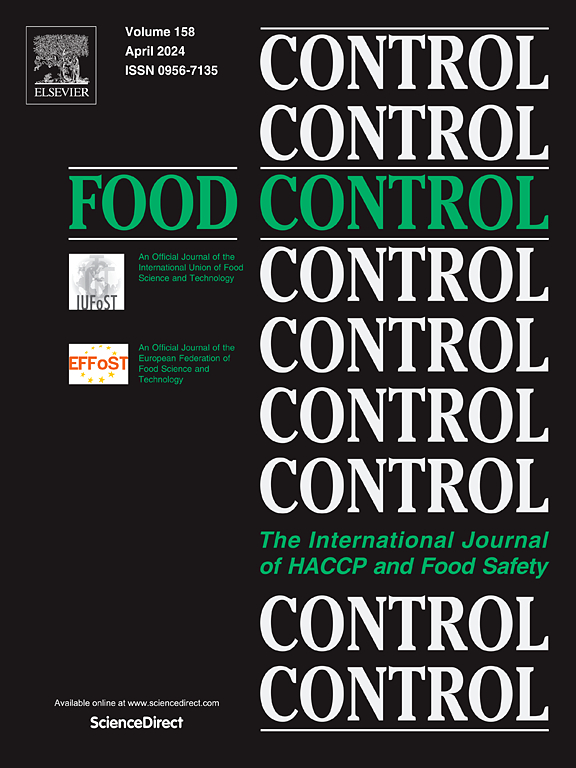Evaluate the freshness and shelf life of refrigerated salted perch (Perca fluviatilis) focusing on the flavor change
IF 5.6
1区 农林科学
Q1 FOOD SCIENCE & TECHNOLOGY
引用次数: 0
Abstract
Steamed perch is a favorite dish in China, and salting is a necessary step before steaming. Due to the abundance of microorganisms in freshwater fish, the cold storage time during the sales stage after salted affects its flavor and safety. This study investigated the dynamic changes in the freshness of the salted perch (salt, 2 %, w/w) during cold storage (0–8 days), and evaluated the shelf life by the conventional methods (TVB-N, TVC, and K-values) (before steaming) and the sensory method (after steaming). The results showed: (1) As refrigeration time extended to 8 days, the freshness of salted perch declined significantly, with TVB-N content increasing to 16.5 mg/100 g, TVC to 5.9 log CFU/g, and K-values to 38.61 %; (2) The optimal shelf life for sensory evaluation was 2 days, which was 6 days shorter than the shelf life obtained by the conventional method; (3) The changes in some flavor compounds might be the main contributors to flavor deterioration and could serve as potential markers for decreased freshness. These compounds include a significant reduction in tartaric acid and inosine-5′-monophosphate (IMP) content (P < 0.05), an increase in the level of bitter amino acids, and alterations occurring in the 18 major key flavor compounds, such as 1-octen-3-ol, methyl trans-9-octadecenoate, hexanal, and nonanal. This research offers novel insights into evaluating the shelf life of aquatic-prepared dishes.
以风味变化为重点,评价冷藏盐鲈鱼的新鲜度和保质期
蒸鲈鱼是中国人最喜欢的一道菜,在蒸之前放盐是必要的一步。由于淡水鱼体内微生物丰富,腌制后销售阶段的冷藏时间会影响淡水鱼的风味和安全性。本研究考察了盐鲈鱼(2%盐,w/w)在冷藏(0 ~ 8 d)过程中新鲜度的动态变化,并采用常规方法(蒸前TVB-N、TVC、k值)和感官法(蒸后)对其货架期进行了评价。结果表明:(1)随着冷藏时间的延长,盐鲈鱼的新鲜度明显下降,TVB-N含量增加到16.5 mg/100 g, TVC增加到5.9 log CFU/g, k值增加到38.61%;(2)感官评价的最佳保质期为2 d,比常规方法缩短6 d;(3)某些风味成分的变化可能是风味变质的主要原因,可以作为新鲜度下降的潜在标志。这些化合物包括酒石酸和肌苷-5′-单磷酸(IMP)含量的显著降低(P <;0.05),苦味氨基酸水平的增加,以及18种主要风味化合物(如1-辛烯醇-3-醇、甲基反式-9-十八烯酸酯、己醛和壬醛)的变化。这项研究为评估水生菜肴的保质期提供了新的见解。
本文章由计算机程序翻译,如有差异,请以英文原文为准。
求助全文
约1分钟内获得全文
求助全文
来源期刊

Food Control
工程技术-食品科技
CiteScore
12.20
自引率
6.70%
发文量
758
审稿时长
33 days
期刊介绍:
Food Control is an international journal that provides essential information for those involved in food safety and process control.
Food Control covers the below areas that relate to food process control or to food safety of human foods:
• Microbial food safety and antimicrobial systems
• Mycotoxins
• Hazard analysis, HACCP and food safety objectives
• Risk assessment, including microbial and chemical hazards
• Quality assurance
• Good manufacturing practices
• Food process systems design and control
• Food Packaging technology and materials in contact with foods
• Rapid methods of analysis and detection, including sensor technology
• Codes of practice, legislation and international harmonization
• Consumer issues
• Education, training and research needs.
The scope of Food Control is comprehensive and includes original research papers, authoritative reviews, short communications, comment articles that report on new developments in food control, and position papers.
 求助内容:
求助内容: 应助结果提醒方式:
应助结果提醒方式:


